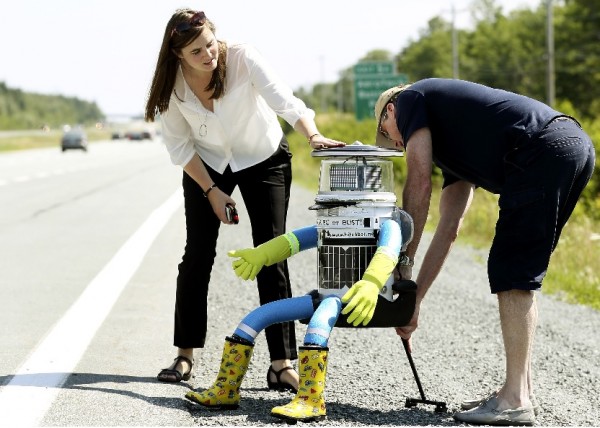Canadian Robot Starts Hitchhiking Journey to See if Humans can be Trusted
| Andy Vitalicio | | Jul 29, 2014 01:32 AM EDT |
(Photo : REUTERS/Paul Darrow) Dr. Frauke Zeller (L) and Dr. David Smith place their anthropomorphic robot named hitchBOT onto the shoulder of Highway 102 outside of Halifax, Nova Scotia, July 27, 2014. The hitch hiking robot is part of a social experiment to see if strangers will help hitchBOT complete its 6,000 kilometer journey from Halifax to Victoria, British Columbia.
This Canadian speaks well, in both English and a little French, tweets and posts photos on Instragram, and wants to travel more than 6,000 kilometers from Nova Scotia to British Columbia. But he can't walk, so he wants to go through the journey hitching rides cross-country.
On Sunday, hitchBOT - yes, he's a robot - started his journey when Brian and Anne Saulnier picked him up from the side of the road outside Halifax, and seatbelted him into the backseat for the first of what will surely be many hops until he gets to Victoria.
Like Us on Facebook
And on his first 24 hours on the journey, he has made it to Quebec, about 1,000 kilometers from the origin.
His developers says he has one big mission that his creators wanted him to do - prove that humans can be trusted.
Dr. Frauke Zeller, assistant professor at Ryerson University in Toronto, says of hitchBOT, "We are asking the question whether robots can trust human beings - and should hitchBOT arrive in Victoria, in all its parts, this would show that 'yes, they can.'"
That means, if hitchBOT gets to his destination in one piece, humans - or Canadians - can be trusted.
On his own website, www.hitchbot.me, hitchBOT says - or his creators say - that he wanted to find out if what he'd been reading about hitchhiking in Canada is true.
"We expect hitchBOT to be charming and trustworthy enough in its conversation to secure rides through Canada, " says Dr. Zeller
With his developers regarding him as part science experiment, part art project, hitchBOT 's body is made from a plastic beer pail, he sports a garbage can hat, and his head and "brain" are protected by a cake saver. His face is mostly LED lights, which also shows his expressions, according to a press release from his creators. Main developer Harris Smith says hitchBOT is made from "odds and ends cobbled together."
HitchBOT's body is wrapped up in solar panels, but he does request motorists to charge him up from their cigarette lighters, so he could continue to tweet and used his embedded GPS - and converse with people.
The robot doesn't walk, and stands only when propped up with a build-in tripod. But he is able to relay route instructions via digital voice and through his LED panels, so motorist would know where best to drop him off.
It does know its exact location and can plan its journey, thanks to its 3G and wifi connectivity.
Now what remains to be done is for motorists to pick him up where he was last dropped off, bring him to a location closer and closer to the west and drop him off could see him and pick him up for the next hop, and plug him into the cigarette lighter so he could continue to report on his progress.
No set routes, no set arrival dates. If all goes well and humans treat him well, hitchBOT will be in Victoria in a few days.
©2015 Chinatopix All rights reserved. Do not reproduce without permission
EDITOR'S PICKS
-

Did the Trump administration just announce plans for a trade war with ‘hostile’ China and Russia?
-

US Senate passes Taiwan travel bill slammed by China
-

As Yan Sihong’s family grieves, here are other Chinese students who went missing abroad. Some have never been found
-

Beijing blasts Western critics who ‘smear China’ with the term sharp power
-

China Envoy Seeks to Defuse Tensions With U.S. as a Trade War Brews
-

Singapore's Deputy PM Provides Bitcoin Vote of Confidence Amid China's Blanket Bans
-

China warns investors over risks in overseas virtual currency trading
-

Chinese government most trustworthy: survey
-

Kashima Antlers On Course For Back-To-Back Titles
MOST POPULAR
LATEST NEWS
Zhou Yongkang: China's Former Security Chief Sentenced to Life in Prison

China's former Chief of the Ministry of Public Security, Zhou Yongkang, has been given a life sentence after he was found guilty of abusing his office, bribery and deliberately ... Full Article
TRENDING STORY

China Pork Prices Expected to Stabilize As The Supplies Recover

Elephone P9000 Smartphone is now on Sale on Amazon India

There's a Big Chance Cliffhangers Won't Still Be Resolved When Grey's Anatomy Season 13 Returns

Supreme Court Ruled on Samsung vs Apple Dispute for Patent Infringement

Microsoft Surface Pro 5 Rumors and Release Date: What is the Latest?










